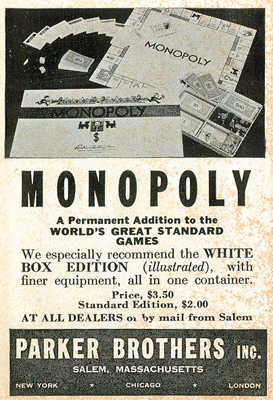Question from Amy K.:
Hello Invention Geek,
Can you trademark a color?
Amy K.
Continue reading “Invention Geek Question – Color Trademark?”

Question from Amy K.:
Hello Invention Geek,
Can you trademark a color?
Amy K.
Continue reading “Invention Geek Question – Color Trademark?”
Question from John M.:
Hello Invention Geek,
Every time I am on the highway, I see a Yellow Freight truck. It has always bothered me that part of the truck and the logo are orange. Why is the Yellow logo orange?
John M.
Question from Jeremy B.:
Hello Invention Geek,
What are the real names of the men pictured on the Smith Brother’s cough drop logo?
Jeremy B.
Question from Emma R.:
Hey Geek,
Is it true that Levi Strauss has sued other jean designers over their back pocket stitches?
Emma
Question from Maggie S.:
Hello Geek,
I have heard many, many different stories about the creation of the Apple logo? What is the true story?
Maggie
 Charles Darrow, an unemployed man living in Germantown, Pennsylvania, created the board game Monopoly in the evenings while trying to make ends meet during the day. In the game, all players have the chance to buy and sell real estate. Living during the great depression, this board game gave the hard pressed workers of the time a chance for fantasy and distraction from their difficult lives.
Charles Darrow, an unemployed man living in Germantown, Pennsylvania, created the board game Monopoly in the evenings while trying to make ends meet during the day. In the game, all players have the chance to buy and sell real estate. Living during the great depression, this board game gave the hard pressed workers of the time a chance for fantasy and distraction from their difficult lives.
Darrow showed his new board game to Parkers Brothers executives and they rejected the idea. They stated that the game had at least fifty-two design flaws including that the game was way too long, the rules were difficult to follow, and there was no real goal for the winner. With help from a friend who was a printer, Darrow went on to manufacture the game himself. He sold 5,000 copies to a local Philadelphia department store. The game was hit. Everyone loved it.
Darrow filed for a US patent on August 31, 1935. On December 31, 1935, he received patent #2,026,082 for a board game apparatus.
One of the copies of the game was bought by the daughter of the founder of Parker Brothers. She suggested that her father take another look at the game. Parker Brother decided to license the patent rights from Darrow. Very quickly, Monopoly was selling over 20,000 copies a week. It was the best selling game in 1935. Darrow went from working odd jobs to get by to a very rich man quickly with the success of his game. Continue reading “The True Monopoly History…”
Question from Ize:
How are fonts protected?
Thanks, Ize
If certain conditions are met, an individual who creates a font has limited options in protecting their typeface. Copyright and trademark laws provide minimal or no protection against typeface piracy. The extent of protection a typeface should receive has been debated about between The U.S Copyright Office and type designers since the 1970s. Design patents are the best option if you want to protect your typeface.
Conditions to receive a design patent:
Question from Margot L.:
In a previous post, you stated that aspirin used to be a trademark name. Where did the name aspirin come from?
-Sarah W.
Aspirin was the brand name given to acetylsalicylic acid by Bayer Corporation of Germany. The name aspirin was derived from the ingredients in the drug. The “a” came from the first letter of the product’s scientific name, acetylsalicylic acid. The “spir” came from the plant Spirea ulmaria, the meadowsweet plant, which was the original source of the compound. The “in” used for the ending was a common ending for medicine at the time.
Bayer was forced to give up trademark rights in U.S., England, France, and Russia in 1919 as part of the Treaty of Versailles. Today, aspirin is the common named used for acetylsalicylic acid in many countries.
Did you know that “Q-Tip”, “Dumpster” and “Thermos” were all trademarks at one time? Once simply brand names for “cotton swabs”, “large waste can” and “vacuum flask” respectively, all have since lost their trademark status to one common problem: genericization.
 Genericized trademarks are words that used to be brand names but have become ingrained in common speech as a way to refer to all brands of a single product, not just the brand or service of the original trademark holder. A trademark often becomes genericized when one company dominates the market for a single product or is the original manufacturer of a new product. The use of a trademark as a verb will also led to the term becoming generic. Continue reading “Say This, Not That: Trademark Genericization”
Genericized trademarks are words that used to be brand names but have become ingrained in common speech as a way to refer to all brands of a single product, not just the brand or service of the original trademark holder. A trademark often becomes genericized when one company dominates the market for a single product or is the original manufacturer of a new product. The use of a trademark as a verb will also led to the term becoming generic. Continue reading “Say This, Not That: Trademark Genericization”
Question from Corra L:
I am always seeing those yellow smiley face images and I was wondering who designed the graphic? Was it ever trademarked?
– Corra
Hello Corra. Those smiley face images are on everything from t-shirts to ads.
 The yellow circle with eyes and a smile that can be seen almost everywhere was designed by a freelance artist for State Mutual Life Assurance in 1963. The company had merged with another insurance company and employee morale was low. In order to improve feelings among the employees, Harvey Ball was asked to create a smiley face to be used on company buttons, letterheads and posters.
The yellow circle with eyes and a smile that can be seen almost everywhere was designed by a freelance artist for State Mutual Life Assurance in 1963. The company had merged with another insurance company and employee morale was low. In order to improve feelings among the employees, Harvey Ball was asked to create a smiley face to be used on company buttons, letterheads and posters.
Ball designed the smiley face in ten minutes and received forty-five dollars for his work. He never tried to sell, trademark or profit from his logo. The graphic fell into the public domain.
Then in 1970, the graphic was made popular by two brothers, Murray and Bernard Spain. Bernard drew the smiley face and Murray added the phrase “Have a happy day.” The brothers trademarked their new graphic and began producing products from T-shirts to cookie jars with the smiley. The smiley face and these products quickly became a fad. By 1972, more than 50 million smiley face buttons had been produced.
Murray and Bernard Spain greatly profited from this trend. The original designer of the smiley did not. He never received any monetary rewards from the design beyond the original forty-five dollar paycheck.